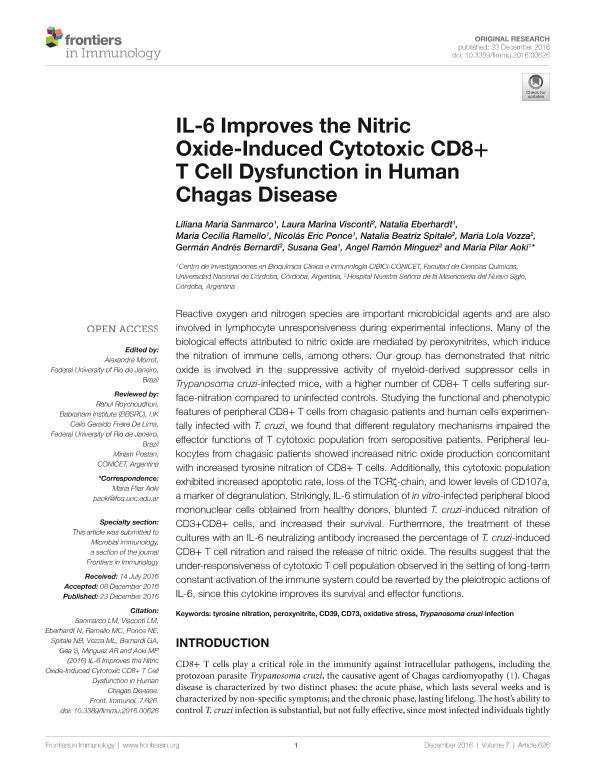Mostrar el registro sencillo del ítem
dc.contributor.author
Sanmarco, Liliana Maria

dc.contributor.author
Visconti, Laura Marina

dc.contributor.author
Eberhardt, Natalia

dc.contributor.author
Ramello, María Cecilia

dc.contributor.author
Ponce, Nicolás Eric

dc.contributor.author
Spitale, Natalia Beatriz
dc.contributor.author
Vozza, Maria Lola
dc.contributor.author
Bernardi, Germán Andrés

dc.contributor.author
Gea, Susana

dc.contributor.author
Minguez, Angel Ramón

dc.contributor.author
Aoki, Maria del Pilar

dc.date.available
2023-01-30T19:44:48Z
dc.date.issued
2016-12
dc.identifier.citation
Sanmarco, Liliana Maria; Visconti, Laura Marina; Eberhardt, Natalia; Ramello, María Cecilia; Ponce, Nicolás Eric; et al.; IL-6 improves the nitric oxide-induced cytotoxic CD8+ T cell dysfunction in human chagas disease; Frontiers Research Foundation; Frontiers in Immunology; 7; DEC; 12-2016; 1-12
dc.identifier.issn
1664-3224
dc.identifier.uri
http://hdl.handle.net/11336/186196
dc.description.abstract
Reactive oxygen and nitrogen species are important microbicidal agents and are also involved in lymphocyte unresponsiveness during experimental infections. Many of the biological effects attributed to nitric oxide are mediated by peroxynitrites, which induce the nitration of immune cells, among others. Our group has demonstrated that nitric oxide is involved in the suppressive activity of myeloid-derived suppressor cells in Trypanosoma cruzi-infected mice, with a higher number of CD8+ T cells suffering surface-nitration compared to uninfected controls. Studying the functional and phenotypic features of peripheral CD8+ T cells from chagasic patients and human cells experimentally infected with T. cruzi, we found that different regulatory mechanisms impaired the effector functions of T cytotoxic population from seropositive patients. Peripheral leukocytes from chagasic patients showed increased nitric oxide production concomitant with increased tyrosine nitration of CD8+ T cells. Additionally, this cytotoxic population exhibited increased apoptotic rate, loss of the TCRζ-chain, and lower levels of CD107a, a marker of degranulation. Strikingly, IL-6 stimulation of in vitro-infected peripheral blood mononuclear cells obtained from healthy donors, blunted T. cruzi-induced nitration of CD3+CD8+ cells, and increased their survival. Furthermore, the treatment of these cultures with an IL-6 neutralizing antibody increased the percentage of T. cruzi-induced CD8+ T cell nitration and raised the release of nitric oxide. The results suggest that the under-responsiveness of cytotoxic T cell population observed in the setting of long-term constant activation of the immune system could be reverted by the pleiotropic actions of IL-6, since this cytokine improves its survival and effector functions.
dc.format
application/pdf
dc.language.iso
eng
dc.publisher
Frontiers Research Foundation

dc.rights
info:eu-repo/semantics/openAccess
dc.rights.uri
https://creativecommons.org/licenses/by/2.5/ar/
dc.subject
CD39
dc.subject
CD73
dc.subject
OXIDATIVE STRESS
dc.subject
PEROXYNITRITE
dc.subject
TRYPANOSOMA CRUZI INFECTION
dc.subject
TYROSINE NITRATION
dc.subject.classification
Enfermedades Infecciosas

dc.subject.classification
Ciencias de la Salud

dc.subject.classification
CIENCIAS MÉDICAS Y DE LA SALUD

dc.title
IL-6 improves the nitric oxide-induced cytotoxic CD8+ T cell dysfunction in human chagas disease
dc.type
info:eu-repo/semantics/article
dc.type
info:ar-repo/semantics/artículo
dc.type
info:eu-repo/semantics/publishedVersion
dc.date.updated
2023-01-27T16:03:04Z
dc.journal.volume
7
dc.journal.number
DEC
dc.journal.pagination
1-12
dc.journal.pais
Suiza

dc.journal.ciudad
Lausana
dc.description.fil
Fil: Sanmarco, Liliana Maria. Consejo Nacional de Investigaciones Científicas y Técnicas. Centro Científico Tecnológico Córdoba. Centro de Investigaciones en Bioquímica Clínica e Inmunología; Argentina
dc.description.fil
Fil: Visconti, Laura Marina. Gobierno de la Provincia de Cordoba. Hospital Misericordia Nuevo Siglo; Argentina
dc.description.fil
Fil: Eberhardt, Natalia. Consejo Nacional de Investigaciones Científicas y Técnicas. Centro Científico Tecnológico Córdoba. Centro de Investigaciones en Bioquímica Clínica e Inmunología; Argentina
dc.description.fil
Fil: Ramello, María Cecilia. Consejo Nacional de Investigaciones Científicas y Técnicas. Centro Científico Tecnológico Córdoba. Centro de Investigaciones en Bioquímica Clínica e Inmunología; Argentina
dc.description.fil
Fil: Ponce, Nicolás Eric. Consejo Nacional de Investigaciones Científicas y Técnicas. Centro Científico Tecnológico Córdoba. Centro de Investigaciones en Bioquímica Clínica e Inmunología; Argentina
dc.description.fil
Fil: Spitale, Natalia Beatriz. Gobierno de la Provincia de Cordoba. Hospital Misericordia Nuevo Siglo; Argentina
dc.description.fil
Fil: Vozza, Maria Lola. Gobierno de la Provincia de Cordoba. Hospital Misericordia Nuevo Siglo; Argentina
dc.description.fil
Fil: Bernardi, Germán Andrés. Gobierno de la Provincia de Cordoba. Hospital Misericordia Nuevo Siglo; Argentina
dc.description.fil
Fil: Gea, Susana. Consejo Nacional de Investigaciones Científicas y Técnicas. Centro Científico Tecnológico Córdoba. Centro de Investigaciones en Bioquímica Clínica e Inmunología; Argentina
dc.description.fil
Fil: Minguez, Angel Ramón. Gobierno de la Provincia de Cordoba. Hospital Misericordia Nuevo Siglo; Argentina
dc.description.fil
Fil: Aoki, Maria del Pilar. Consejo Nacional de Investigaciones Científicas y Técnicas. Centro Científico Tecnológico Córdoba. Centro de Investigaciones en Bioquímica Clínica e Inmunología; Argentina
dc.journal.title
Frontiers in Immunology
dc.relation.alternativeid
info:eu-repo/semantics/altIdentifier/url/https://www.frontiersin.org/articles/10.3389/fimmu.2016.00626/full
dc.relation.alternativeid
info:eu-repo/semantics/altIdentifier/doi/http://dx.doi.org/10.3389/fimmu.2016.00626
Archivos asociados
